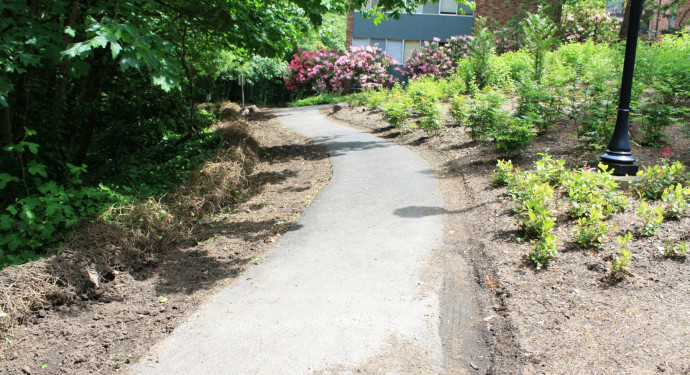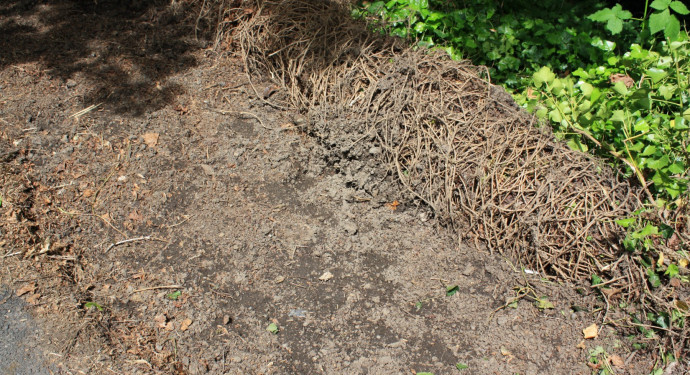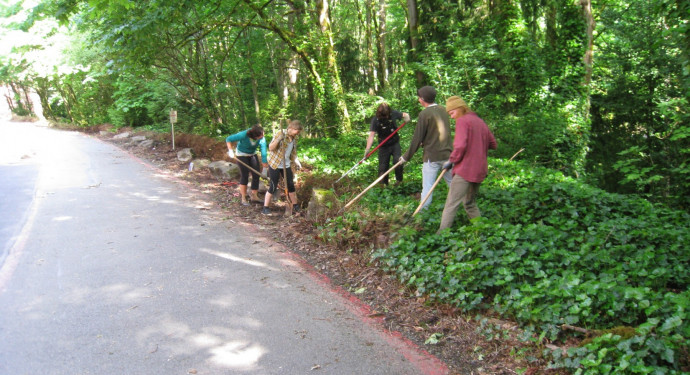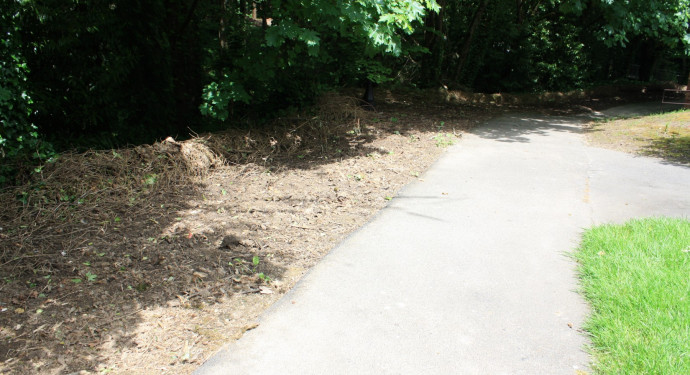Native Habitat Improvement & Invasive Species Removal
Lewis & Clark is known for its beautiful natural setting and commitment to the environment. This translates into years of work to improve the appearance and biological health of the great habitats surrounding our campus. As we continue with our Salmon Safe certification program, mass removal of the invasive species identified on our property and bordering neighboring properties has proven crucial to protecting biodiversity and enhancing the health and resiliency of our native species and their habitats.
Overview
Research, mapping, and on site action by our students, faculty and staff has supported invasive species removal for several years. In 2014, we are leveraging this work to begin an intensive 3-year program to remove invasives across our three campuses. The removal process requires a variety of methods and tools which vary according to the plant species, time of year and location of the infestation. We have selected manual and chemical treatments that are proven to be effective through scientific research, cause minimal ecological harm, are economically feasible and appropriate for the site. Any chemical treatment applied will be done in such a manner as to protect native plants, animals and waterways. The process will be similar to that which was used in the neighboring City of Portland’s Riverview Natural Area and has been reviewed with faculty, staff and the Sustainability Council.
One - Page Project Summary and Herbicide Information
Active Partners & Stakeholders
Lewis & Clark was approached by the West Multnomah Soil & Water Conservation District, City of Portland, SOLVE, Tryon Creek State Parks in the summer of 2013, to begin the conversation of a collaborative effort to remove invasive species across our sub-region. This initial contact led to a partnership between Lewis & Clark and these stakeholders groups, which has resulted in jointly developing, funding, and beginning implementation of invasive species removal on our contiguous properties (Tryon Creek State Park, City of Portland’s Riverview Natural Area, and L&C).
At L&C, the CAS Biology department, the Grounds Department, Lewis & Clark Sustainability Council, the Law School and others, have been actively involved in invasive species research, removal, policy and program development. These groups as well as several student groups, will be active participants in the program moving forward.
Project Plan
The approach to this project has been developed over the course of a year in coordination with internal stakeholders and community partners. The project will be implemented within an Integrated Pest Management framework;
Integrated pest management is the coordinated use of pest and environmental information with available pest control methods to prevent unacceptable levels of pest damage by the most economical means with the least possible hazard to people, property and the environment. The goal of integrated pest management is to manage pests and the environment so as to balance costs, benefits, public health and environmental quality. Integrated pest management systems use all available technical information on the pest and its interactions with the environment. Because integrated pest management programs apply a holistic approach to pest management decision making, they take advantage of all appropriate pest management options, including, but not limited to pesticides. Thus integrated pest management is: a system using multiple methods; a decision-making process; a risk reduction system; information intensive; cost-effective; site specific. — USEPA
Due to the steep slopes throughout our campus (and related erosion concerns), the scope of the project, and the level of infestation, careful direct, spot spraying by licensed applicators of two aquatically labeled herbicides ([4% Accord Concentrate (glyphosate)]) + [2%Garlon 3A (triclopyr amine)] + [2% Competitor (modified vegetable oil surfactant)]) will be used for treatment of some invasives. Herbicide treatments will help minimize erosion on steep, slide prone slopes and native plants will be installed directly into the dead invasive plant material. The utmost care will be used to not harm beneficial plants on site and careful consideration of timing of manual and mechanical methods employed will minimize impacts to the environment. For example, trails, native plants, and waterways will be buffered when herbicides are applied. Contractors crews also look for any signs of wildlife while applying both manual and chemical methods; critical nesting and habitat seasons are avoided unless no evidence of wildlife is found.
The schedule for this project is largely dependent on the growth pattern of the targeted species, but also varies with temperature, wind direction, precipitation and habitat considerations. When contractors are working, areas will be posted with the type and duration of work.
Invasive species to be removed: English Ivy, Blackberry, Garlic Mustard, Knotweed, Holly, Laurel, Norway Maple, Cherries, Clematis, Robert’s & Shiny Geranium
Salmon Safe and Herbicide Treatment
The Salmon-Safe standards do not preclude herbicide use, but do require specific standards be met. From the Salmon-Safe certification standard for university campuses: A.4 – “All pesticide use, including any applications by landscape contractors, occurs within the context of an integrated pest management (IPM) program as documented in a comprehensive written plan.” Additionally, Lewis & Clark was required to complete in-depth research into alternatives and consult outside IPM experts, to gain approval of the herbicide use.
Similarly, Portland Parks & Recreation is certified Salmon-Safe for all of their properties, and includes the following in its report: “Pesticide use within Portland’s well-established IPM program is minimal and well justified. Pest management decisions and methodology are based on sound scientific information. The Portland program has served as a model for others that IPM is practical and effective as well as ecologically responsible.”
Post-Removal Approach and Native Species Reintroduction
Literature, Research and Resources
L&C Collaborative Research and Student Papers
-
Bierzychudek, Paulette. Investigating Forest Recovery in River View Natural Area After Removal of Invasive Plant Species
-
Gasik, Novak Groshong. Does Ivy Growth in Riverview Natural Area Affect Soil Nutrients Required for Miner’s Lettuce to Grow?
-
Smith, Robbins, Horigan. The Effect of Hedera Helix on Soil Nutrients from the Riverview Nature Area and Lewis & Clark College Campus
- O’Gallagher, Houlberg, Morillo. Soil that previously contained an invasive species or herbicide result in no significant effect on the growth of native plants
Peer-reviewed Papers & Academic Research
- Biggerstaff, Matthew S. and Christopher
- Garlic Mustard, Invasion Biology Introduced Summary Project, Columbia University
-
Invasive species harms hardwoods by killing soil fungus
- Glyphosate Aquatic Herbicides; an Overview of Risk
Regional Resources
- City of Portland Integrated Pest Management Plan
- West Multnomah Soil and Water Conservation District - Invasives Plant List
- Oregon Metro — Integrated Pest Management
- www.4countycwma.org
Residential Resources
- Garden Smart; A Guide to Non-Invasive Plants
- City of Portland Invasive! Plants Poster (identification and removal methods)
- Backyard Habitat Information - Audubon Society
State Resources
National Resources
Facilities Services is located in Facilities Services on the Undergraduate Campus.
MSC: 76
email facility@lclark.edu
voice 503-768-7845
fax 503-768-7023
Associate Vice President of Facilities Services David Ernevad
Facilities Services
Lewis & Clark
615 S. Palatine Hill Road MSC 76
Portland OR 97219



